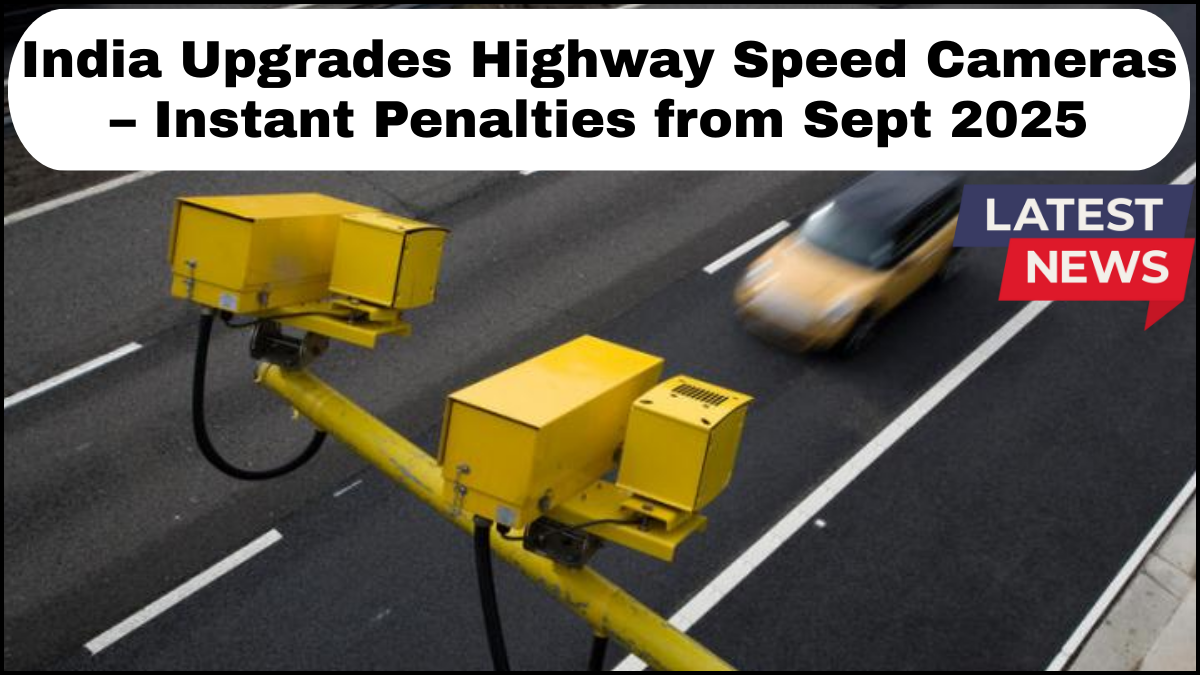India is taking a decisive leap forward in road safety enforcement with the rollout of upgraded Highway Speed Cameras Active across major national highways starting September 2025. This high-tech initiative is part of a comprehensive penalty system upgrade aimed at curbing overspeeding, a leading cause of accidents on Indian roads.

H3: What’s Changing in 2025?
From September 2025 onward, speed monitoring on Indian highways won’t rely solely on random checks or sporadic enforcement. The government is activating a country-wide network of AI-powered highway speed cameras that can instantly detect violations and trigger automated penalty issuance without human intervention.
These cameras are being installed at strategic intervals along expressways, national highways, and other high-risk corridors. Unlike the older models, which simply captured speed data and images, the new system integrates with the Ministry of Road Transport and Highways (MoRTH) database and the Vahan portal. This ensures that any vehicle caught overspeeding will immediately trigger a fine, which is sent digitally to the vehicle owner’s registered contact information.
H3: How the New Speed Camera System Works
Each camera is equipped with Automatic Number Plate Recognition (ANPR) technology, radar-based speed detection, and real-time connectivity to central traffic servers. When a vehicle exceeds the prescribed speed limit:
-
The camera records the speed and captures a high-resolution image.
-
The number plate is matched with the national vehicle registry.
-
An e-challan (electronic fine) is generated and sent within seconds to the violator.
This system eliminates human error, corruption, or delays often associated with manual enforcement.
H3: Why This Penalty System Upgrade Matters
Overspeeding accounted for over 65% of fatal road accidents in India, according to recent National Crime Records Bureau (NCRB) data. The penalty system upgrade is designed to address this critical issue in three major ways:
-
Instant accountability: Drivers are no longer immune due to lack of on-site enforcement.
-
Behavior correction: Real-time penalties are expected to alter reckless driving habits faster than traditional methods.
-
Data-driven safety: Authorities can now analyze traffic behavior patterns and adapt enforcement in real time.
H3: New Fines and What Drivers Should Expect
With this upgrade, the government is also increasing the fine amount for overspeeding, especially on high-speed corridors like the Delhi-Mumbai Expressway. Repeat offenders may face:
-
Heavier fines (ranging from ₹1,000 to ₹5,000 depending on the speed and location)
-
Suspension of driving licenses
-
Higher insurance premiums
-
Points added to their driving record (part of the upcoming National Road Safety Score system)
H3: Rollout Timeline and Coverage
The initiative is being rolled out in phases. By September 2025, over 1,200 high-speed cameras will be operational across:
-
National Highways Authority of India (NHAI) corridors
-
Golden Quadrilateral network
-
High-density freight and passenger corridors
-
Selected state highways with high accident rates
The Ministry has partnered with global technology providers to ensure accuracy, reliability, and 24/7 functionality, regardless of weather or lighting conditions.
H3: How Drivers Can Prepare
To avoid sudden penalties once the system is live, drivers should:
-
Be aware of local speed limits (typically 100 km/h for cars on expressways, 80 km/h on national highways)
-
Regularly check their e-challan status through official portals like https://echallan.parivahan.gov.in
-
Maintain updated contact and registration details in the Vahan database
-
Consider installing GPS-based speed alerts or dashcams for added awareness
H3: Implications for Road Safety and Traffic Management
The activation of highway speed cameras and the new penalty system upgrade is not just about fines—it represents a paradigm shift in how India manages road safety. It will allow for:
-
Real-time traffic monitoring
-
Automated emergency alerts
-
Smarter city and highway planning based on collected data
If successful, this model may be replicated in urban areas to reduce inner-city accidents and traffic congestion.
FAQs
Q1: Will the speed cameras be visible or hidden?
A: Most cameras will be clearly marked to encourage compliance, but some covert units may be used in accident-prone zones.
Q2: Can I contest an e-challan generated by a speed camera?
A: Yes. Challans can be contested online through the eChallan portal if you believe it was issued in error. Evidence such as GPS logs or dashcam footage can support your case.
Q3: What happens if I don’t pay the fine?
A: Non-payment can result in increased fines, legal notices, and even license suspension or vehicle seizure for repeated violations.
Q4: Are all vehicles monitored equally?
A: Yes. Two-wheelers, private cars, and commercial vehicles are all subject to the same system, though speed thresholds may vary by category.
Q5: Will there be a grace period after the system launches?
A: Authorities may allow a short awareness phase in selected areas, but instant penalties will begin nationally from September 2025.
click here to learn more